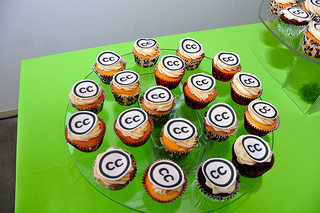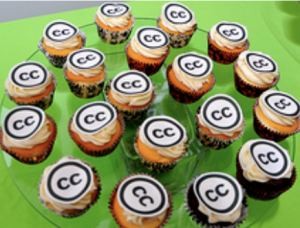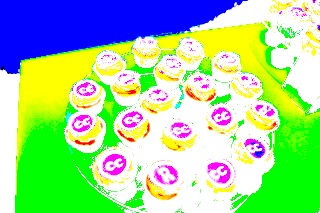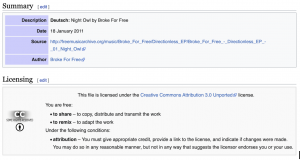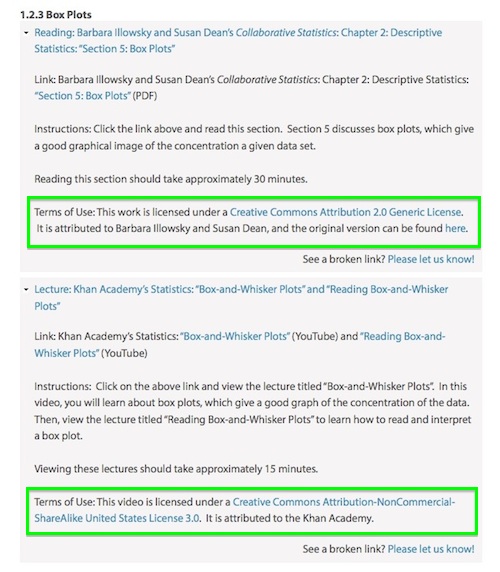Difference between revisions of "Recommended practices for attribution"
(→Attributing music when you are not adding new elements to it) |
(→Attributing music when you are not adding new elements to it) |
||
| Line 167: | Line 167: | ||
When you re-use music without adding new elements to it, you are not making an adaptation. In that case, you can rely on any of the CC licenses, including CC BY-ND and CC BY-NC-ND. We recommend providing attribution information in writing. | When you re-use music without adding new elements to it, you are not making an adaptation. In that case, you can rely on any of the CC licenses, including CC BY-ND and CC BY-NC-ND. We recommend providing attribution information in writing. | ||
| − | + | [[File:Wiki_page_attributing_night_owl.png|thumbnail]] | |
| − | [ | + | On [https://commons.wikimedia.org/wiki/File:Broke_For_Free_-_01_-_Night_Owl.ogg|this Wikipedia page], you can see an example of great attribution for the sharing another soundtrack, “Night Owl” by Broke for Free, when it’s without adaptation. |
''Let’s go through TASL:'' | ''Let’s go through TASL:'' | ||
Revision as of 21:10, 22 November 2022
You can use CC-licensed materials as long as you follow the license conditions. One condition of all CC licenses is attribution: crediting the author and giving the source information. Generally speaking, attribution must reasonably include all relevant information supplied by the licensor. Because each use case is different, you can decide what form of attribution is most suitable for your specific situation. The following examples are intended to illustrate what typical prudent practices look like. We expect community norms and expectations to evolve with time, and will adapt this guide accordingly. In addition to attribution, there are also things to consider as a licensor or a licensee. If you are a licensor and would like to learn how to mark your own material with a CC license, here.
Contents
- 1 Basic components of attribution
- 2 Examples of attribution in different media
- 3 Title, Author, Source, License
- 4 Attribution in specific media
- 5 If you want to get Technical
- 6 Other guides to attribution
Basic components of attribution
Whenever you are reusing CC licensed works, we recommend that the attribution include the Title, Author, Source, and License. This is true whether you’re sharing the work as-is or if you have made an adaptation. To remember these attribution elements, it’s helpful to think of the acronym: TASL.
Let’s now go through TASL — we will explain each element in more detail:
Title: What is the name of the work?
- If a title was provided for the work, include it as a part of the attribution. Sometimes a title is not provided; in that case, there’s no need to mention the title.
- The inclusion of title is a requirement of all CC licenses version 3.0 or earlier, and it is optional for the 4.0 suites. See Devil in the details.
Author: Who allows you to use the work?
- We often use “author” as a shorthand when we are, legally speaking, referring to the “licensor” (a.k.a., the “copyright holder” or “rightsholder”). This is because, in most CC-licensed works, the licensor is the same person or entity as the author. When an author is licensing their work under a CC license, and has made their name available, include the author’s name as a component in your attribution. Sometimes, the licensor may want you to give credit to some other entity, like a company or institution, or the licensor may want to be credited by a pseudonym instead of their real name. In rare cases, the licensor may not want to be attributed at all. In all of these cases, do what the licensor requests.
- Sometimes, the author will also provide a copyright notice, which consists of the copyright symbol, year of publication, and the name of the author/licensor. Include the copyright notice as a part of your attribution if such information is provided.
Source: Where can people find the work?
- Please make it possible for future users to find the source of the material by including a URL or hyperlink where the work resides. This often is where you found the work. If you found it somewhere other than the original site, try to include information about the original site where the work was first shared publicly. It is also better to use the original URL instead of a shortened link, whether you are hyperlinking or printing out the entire URL.
License: How can you use the work?
- You must specify which CC license was applied to the work you are reusing. Each of the six different CC licenses come with distinct requirements for re-use. We recommend that you name and provide a link to the license, e.g., BY 4.0 (http://creativecommons.org/licenses/by/4.0) for a work licensed under CC BY 4.0.
- Consider also including the “disclaimer of warranties,” which clarifies that the author makes no representations or warranties about the non-infringement or absence of other defects concerning the CC-licensed work. In plain English, this means that the users will use the work at their own risk.
- To sum up, if the licensor has provided any information related to TASL, consider including them in your attribution. We also recommend providing links to the Title, Author, Source, and License, where possible, so future users can easily access the information they need on a work and the license terms.
Examples of attribution in different media
We will now look at some examples in different media.
Attributing an image
Here is a photo. Below the photo, we will go over some good and bad examples of how people might attribute it.
This is a great attribution
Let’s go through TASL:
- Title? "Creative Commons 10th Birthday Celebration San Francisco"
- Author? "Timothy Vollmer" - linked to his profile page
- Source? "Creative Commons 10th Birthday Celebration San Francisco" - linked to original Flickr page
- License? "CC BY 4.0" - linked to license deed
Most importantly, this attribution reasonably includes all the relevant information provided by the author.
This is a pretty good attribution
Let’s go through TASL:
- Title? Title is not noted but at least the source is linked.
- Author? "Timothy Vollmer"
- Source? "Photo" - linked to original Flickr page
- License? "CC BY" - linked to license deed
As you see, a good attribution includes all the essential TASL elements, even though they may not mirror the format of credit the author has requested.
This is an incorrect attribution
Let’s go through TASL:
- Title? Title of the image is not noted
- Author? Author is not noted (It is a common mistake to attribute CC-licensed photos to CC, but Creative Commons is not the author!)
- Source? No link to the original source
- License? There is no mention of a license nor a link to the license. "Creative Commons" is the name of an organization; it does not equate to any of the licenses maintained by the Creative Commons.
This is a great attribution for an image you modified slightly
Here, information on Title, Author, Source, and License are all included as requested by the author. The slight modification is also noted and briefly described.
Note if the modification changes the work’s meaning in a way that would be considered creative — that is, not a purely mechanical change or a simple crop/excerpt that keeps the original message undistorted, it would be considered creating a new adaptation of the original work. You cannot rely on a CC license that does not allow adaptation (e.g., CC BY-ND or CC BY-NC-ND) when making such modifications.
This is a great attribution for when you have created an adaptation
Let’s go through TASL:
Original Title, Author, Source, and License are all noted.
The original work is referenced and the fact that it is an adaptation is also noted, so viewers can see what has changed.
The author and other attribution information for the new adapted work is also noted.
Note: If you're at a point where you are licensing works that are adaptations, go to Marking your work with a CC license.
Attributing music
Attributing music when you incorporate it in an audio or video recording
Music (both the underlying composition and the sound recordings) — such as a song, or a recording of natural sounds — can be attributed within the audio/video, and in the description text of the audio/video. How to attribute a CC licensed music in an audio or video recording will largely depend on what is reasonable for a chosen medium and platform.
Caution: Licenses with “ND” do not allow for adaptations. Your use of CC-licensed music is often an adaptation!
It is considered adaptation if you incorporate CC-licensed music into your work in a way that the CC-licensed music can no longer be seen as a stand-alone piece. For example, if you are using a song as background music in a podcast or in a video, it is considered an adaptation of the song.
Keep in mind that CC BY-ND and CC BY-NC-ND do not allow adaptations (although you may be authorized by law to do so, such as under a users’ right like fair use, or you may ask for the author’s permission independent of the CC license).
This is a great attribution of background music in a podcast or a video
When reasonable to do so, we recommend that you include attribution both in the description box and in the podcast recording or the video recording itself.
If you are using the following song in a podcast: ‘Day Bird’ by Broke for Free (brokeforfree.com), this would be a great way to provide attribution (which you can see in [Creative Commons podcast]) —
- At the end of the podcast audio recording, the host says:
-
Special thanks to the musician Broke for Free, whose track “Day Bird” you heard at the beginning of this episode and you are listening to right now. It's under the Creative Commons Attribution License, meaning it's free for anyone to use. You can find it at the Free Music Archive—freemusicarchive.org
- In the description box, the information text reads:
-
Theme music: “Day Bird” by Broke for Free (brokeforfree.com). Available for use under the CC BY 3.0 license (creativecommons.org/licenses/by/3.0/), at [Free Music Archive].
Let’s go through TASL:
- Title? Both the recording and the description box include the title of the work, “Day Bird”
- Author? "Broke for Free," again, noted both in the recording and in the description box
- Source? Both the author’s page and the archive’s page are included with links
- License? "CC BY 3.0" — linked to license deed
You cannot talk over, or remix, music licensed under CC BY-ND or CC BY-NC-ND.
This is a bad attribution of background music in a podcast or a video
A bad attribution is one where you do not provide enough information for a user to find the music you are using. The following is a bad attribution for the same song:
-
No attribution is included in the podcast recording or the video itself.
In the description box, it says: “ Creative Commons music.”
Let’s go through TASL:
- Title? Title is not noted
- Author? Author is not noted
- Source? Source is not noted; users cannot find the specific song used in the podcast
- License? No information on the CC license
The attribution information is not sufficient for people to find the song you have re-used.
Attributing music when you are not adding new elements to it
When you re-use music without adding new elements to it, you are not making an adaptation. In that case, you can rely on any of the CC licenses, including CC BY-ND and CC BY-NC-ND. We recommend providing attribution information in writing.
On Wikipedia page, you can see an example of great attribution for the sharing another soundtrack, “Night Owl” by Broke for Free, when it’s without adaptation.
Let’s go through TASL:
Title? Title of the work, “Night Owl,” is noted
Author? "Broke for Free," noted and linked to the author’s webpage
Source? A link is provided for the source
License? "CC BY 3.0" — linked to license deed
This is a good attribution for material from multiple sources
Because:
- Title? Specific works are named, eg. "Box-and-whisker Plots"
- Author? Different authors noted for the different works.
- Source? Original materials are linked for each work
- License? The different licenses (Creative Commons Attribution for Collaborative Statistics and Creative Commons Attribution-Noncommercial-ShareAlike for the Khan Academy video) are spelled out and linked for each work
- Lastly, it is clear which attribution belongs to which work.
You can visit the Saylor.org Introduction to Statistics course page to see how they marked it up directly.
Title, Author, Source, License
A good rule of thumb is to use the acronym TASL, which stands for Title, Author, Source, License.
Title - What is the name of the material?
- If a title was provided for the material, include it. Sometimes a title is not provided; in that case, don't worry about it.
Author - Who owns the material?
- Name the author or authors of the material in question. Sometimes, the licensor may want you to give credit to some other entity, like a company or pseudonym. In rare cases, the licensor may not want to be attributed at all. In all of these cases, just do what they request.
Source - Where can I find it?
- Since you somehow accessed the material, you know where to find it. Provide the source of the material so others can, too. Since we live in the age of the Internet, this is usually a URL or hyperlink where the material resides.
License - How can I use it?
- You are obviously using the material for free thanks to the CC license, so make note of it. Don't just say the material is Creative Commons, because that says nothing about how the material can actually be used. Remember that there are six different CC licenses; which one is the material under? Name and provide a link to it, eg. http://creativecommons.org/licenses/by/4.0/ for CC BY.
- → If the licensor included a license notice with more information, include that as well.
Lastly, is there anything else I should know before I use it?
- When you accessed the material originally did it come with any copyright notices; a notice that refers to the disclaimer of warranties; or a notice of previous modifications? (That was a mouthful!) Because that kind of legal mumbo jumbo is actually pretty important to potential users of the material. So best practice is to just retain all of that stuff by copying and pasting such notices into your attribution. Don't make it anymore complicated than it is -- just pass on any info you think is important.
- → Regarding modifications: Don't forget to note if you modified the work yourself (example). If you are at the point where you are creating and licensing derivative works (example), see Marking your work with a CC license.
These best practices are based on actual CC license requirements. Noting the title is a requirement of all CC licenses version 3.0 or earlier, optional for 4.0. Noting the author, source, license, and retaining any extra notices is a requirement of all CC licenses. See Devil in the details.
Devil in the details
If you have any doubts or questions, you can read the complete attribution requirements which are spelled out in detail in the legal code of every CC license, eg. http://creativecommons.org/licenses/by/4.0/legalcode#s3a. This chart compares the detailed requirements across all versions of CC licenses.
Don't make it too complicated
The license tells you to be reasonable:
- You may satisfy the conditions in (1) and (2) above in any reasonable manner based on the medium, means and context in which the Licensed Material is used. For example, it may be reasonable to satisfy some or all of the conditions by retaining a copyright notice, or by providing a URI or hyperlink associated with the Licensed Material, if the copyright notice or webpage includes some or all of the required information.
There is no one right way; just make sure your attribution is reasonable and suited to the medium you're working with. That being said, you still have to include attribution requirements somehow, even if it's just a link to an About page that has that info. (More on different mediums below.)
Attribution in specific media
As stated above, best practices for attribution apply as reasonable to the medium you're working with. For media such as offline materials, video, audio, and images, consider:
- 1. Publishing a web page with attribution information. For example, on a webpage featuring your audio recording, provide a credit list of material you used that adheres to best practices above. Doing so allows not only your material, but the materials you attribute, to be found by search engines and other web discovery tools. If possible within the medium, make the Author, Source, and License links the user can follow.
-
Example:
This video features the song "Desaprendere (Treatment)" by fourstones, available under a Creative Commons Attribution-Noncommercial license.
- 2. Mentioning the credits within the media itself. For example, crediting videos can be a simple list of the materials used with their associated licenses in a screen at the end of a video. For audio, it can be a verbal recitation of credits at the end of the recording.
-
Video example 1: "Science Commons" by Jesse Dylan - see attribution starting at 1:52
Video example 2: "Video Editing and Shot Techniques: Study of jump cuts, match cuts and cutaways " video by New Media Rights - see attribution starting at 3:21
Audio example: "Down and Out in the Magic Kingdom" by Cory Doctorow read aloud. Mastered by John Taylor Williams - listen to attribution starting at 17:08
If you want to get Technical
If you really want to go there, we have a document about marking materials so that they are machine-readable.
Also, several groups are exploring ways to make attribution easier and simultaneously machine-readable for the web. Here are some tools that have been developed:
- Open Attribute - a browser plugin for Firefox and Chrome that grabs the CC license metadata on a web page and turns it into an attribution for you
- Commons Machinery - a suite of plugins for Firefox and open office tools that enables copying and pasting images with the attribution info already attached
Other guides to attribution
- How To Attribute CC Photos poster by foter
- Attributing Creative Commons Material (pdf) - Creative Commons Australia's publication is full of examples with colorful imagery.
- How to attribute works you reuse under a Creative Commons license by New Media Rights provides real world examples by different media type
- Library Resources Fox Valley Technical College provides examples of suggested OER attribution and citations. They recommend the following TASL format: “Content Title” from Encompassing Container Title, Version, by Author © Copyright date [Alternate owner if different from Author] is licensed with License [URL of license description]. Access at DOI or permalink or URL. Additional Publisher notes or licensing requirements.
